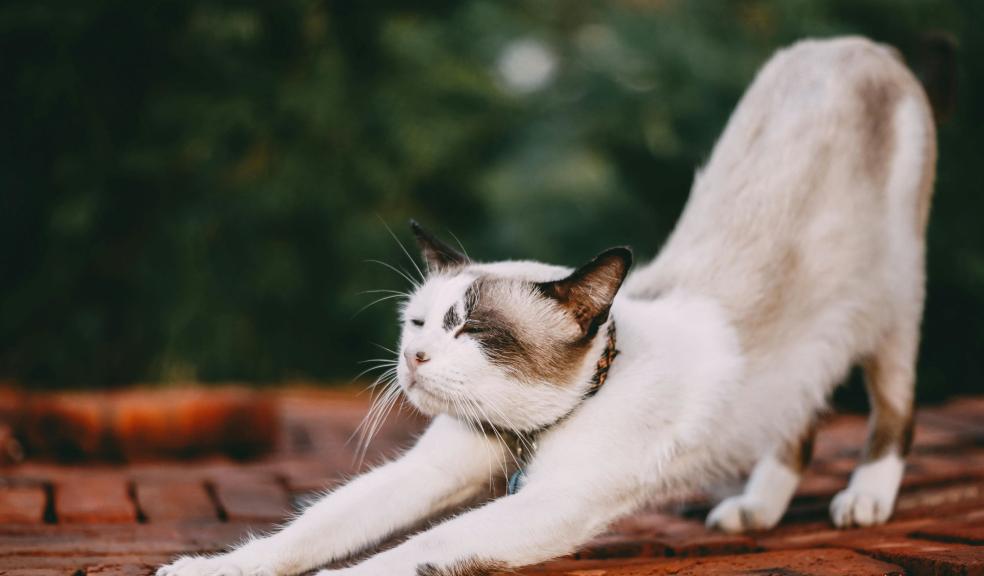
Expert shares feline fitness advice
Indoor cats are particularly at risk of being overweight, as they likely spend more time snuggling up in a warm corner than exploring the neighbourhood. However, there are still a few ways you can get your cat moving and feeling fit, all while having fun. If you're worried about your pet's weight, or if you just want to keep them purr-fectly healthy and active, here the experts from Catit share their feline fitness tips to try with both indoor and outdoor cats.
Try some relaxing cat yoga
Cats naturally like to stretch, whether they're just getting up from an afternoon nap or preparing for playtime. Stretching like this helps to reduce the risk of injury by keeping joints and muscles flexible. However, some cats, particularly older cats, may not indulge in the feeling of a good stretch as often as they should. Luckily, you can encourage them to stretch yourself with a few simple exercises.
When doing any form of play or exercise, your cat's comfort should always be your number one priority. Only do cat stretches if they are comfortable with the movement and be sure to stop if they show any sign of discomfort.
Neck stretch
Hold a treat or a favourite toy slightly above your cat's head. As they reach for it, gently guide their head upwards, encouraging them to stretch their neck and spine.
Paw extensions
Take one of your cat's front paws and gently pull it forward, encouraging a paw extension. Hold the position for a few seconds, then release. Repeat with the other front paw.
Similarly, while your cat is standing or sitting, gently lift one of their front legs and extend it forward. This stretch can help with their shoulder and front leg flexibility. Hold for a few seconds, then release and repeat on the other side.
Back arch stretch
When giving your cat a brush or a comb, gently stroke along their back from head to tail. Many cats enjoy the sensation and will stretch and arch their back in response.
Leg and hip stretch
While your cat is in a relaxed state, gently take one of their hind legs and extend it backwards, being careful not to apply too much pressure. Hold the leg in the extended position for a few seconds, then release. Repeat with the other hind leg.
Get them moving with interactive cat toys
Exercising your cat with interactive toys is not only enjoyable for them but also a fantastic way to keep them physically and mentally stimulated. Laser toys and wand toys with feathers, bells, or strings can engage your cat's natural hunting instincts and provide hours of fun.
Additionally, investing in moving cat play circuits can offer a dynamic environment for your feline friend. With these, your cat can chase a moving ball that zips around the track. They can also be configured into different combinations, so your cat never gets bored. To maximize the benefits even more, try to rotate between various interactive toys to ensure your cat stays engaged.
Encourage your cat to forage for their meals
Even mealtimes can be a great opportunity to exercise your cat. Treat-dispensing toys and puzzle feeders encourage your cat to work for their food, promoting physical activity before they eat. Gradually introduce the puzzle during mealtimes, placing a portion of their daily food inside. As your cat learns to manipulate the toy to access their food, they'll expend energy and stimulate their mind, contributing to weight loss and overall well-being. Treat dispensers and slow feeders also encourage cats to slow down their eating pace, which can help prevent binge eating.
Set up an engaging obstacle course
As cats are natural hunters, you can appeal to their instincts by setting up an obstacle course for them to jump, climb, and crawl through. Take a look around your house and see what you can use to create obstacles. For instance, a large cushion can be transformed into a ramp, while any tall object like a bottle can be used as weave poles. You could also add a pop-up cat tunnel to the mix which can be collapsed after use to save space. Even existing pieces like a cat tower can offer plenty of opportunities for your cat to jump and climb throughout the day.
"Most cats need around 20 minutes of active play each day but may need more or less depending on their age. Kittens benefit from more activity, while senior cats may only need around 15 minutes of exercise to keep healthy. Of course, cats generally like to nap during the day and play in short bursts, so working with their natural energy levels can make exercising much easier.
"A good diet is also key to a fit and healthy cat. Make sure you're feeding your pet high-quality cat food that meets their specific life stage and dietary requirements and consider consulting with a vet to create a nutrition plan tailored to your cat's individual needs. Automatic feeders can also prevent binge eating, delivering pre-portioned meals at dedicated times."- Paul Trott, UK Marketing Manager at Catit







